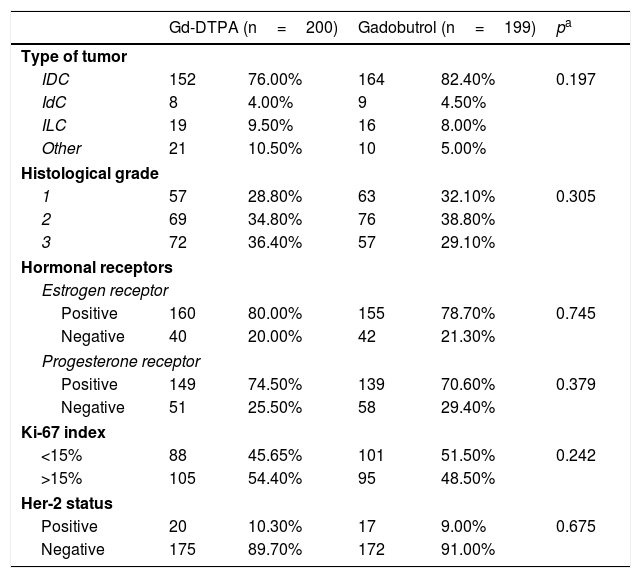To compare the pharmacokinetic profile of gadobutrol versus Gd-DTPA in dynamic contrast-enhanced MRI (DCE-MRI) in patients with breast cancer. Secondary objectives included comparing the safety profiles and diagnostic efficacy of the two contrast agents for detecting additional malignant lesions.
Material and methodsThis retrospective observational study included 400 patients with histologically confirmed breast cancer; 200 underwent DCE-MRI with Gd-DTPA (Magnevist®) and 200 underwent DCE-MRI with gadobutrol (Gadovist®). Pharmacokinetic parameters and signal intensity were analyzed in a region of interest placed in the area within the lesion that had greatest signal intensity in postcontrast sequences. We compared the two groups on pharmacokinetic variables (Ktrans, Kep, and Ve), time-signal intensity curves, and the number of additional malignant lesions detected.
ResultsThe relative signal intensity (enhancement) was higher with gadobutrol than with Gd-DTPA. Washout was lower with gadobutrol than with Gd-DTPA (46% vs. 58.29%, respectively; p=0.0323). Values for Ktrans and Kep were higher for gadobutrol (p=0.001). There were no differences in the number of histologically confirmed additional malignant lesions detected (p=0.387).
ConclusionsRelative enhancement is greater with gadobutrol, but washout is more pronounced with Gd-DTPA. The number of additional malignant lesions detected did not differ between the two contrast agents. Both contrasts are safe.
Evaluar el perfil farmacocinético del gadobutrol en comparación con el Gd-DTPA, en resonancia magnética de mama con contraste (RM-DC). El objetivo secundario es valorar la eficacia diagnóstica en la detección de lesiones adicionales tumorales en RM-DC, y el perfil de seguridad de ambos contrastes.
Material y métodosEstudio retrospectivo y observacional que incluyó 400 pacientes con diagnóstico histológico de cáncer mamario. A 200 pacientes se les realizó RM-DC con contraste Gd-DTPA (Magnevist®) y a las otras 200 con gadobutrol (Gadovist®). Se analizaron los parámetros farmacocinéticos y la intensidad de señal mediante una ROI (region of interest) en el área intralesional con mayor intensidad de señal en las secuencias poscontraste. Se compararon las variables farmacocinéticas (Ktrans, Kep y Ve) y las curvas de intensidad de señal-tiempo de ambos grupos, así como el número de lesiones adicionales tumorales detectadas con ambos contrastes.
ResultadosEl realce relativo de intensidad de señal es más alto con gadobutrol que con Gd-DTPA. El gadobutrol muestra significativamente menos lavado (46%) que el Gd-DTPA (58,29%) (p=0,0323). Se observan valores más altos de Ktrans, Kep y Ve para el gadobutrol, siendo la diferencia estadísticamente significativa para los dos primeros parámetros (p=0,001). No se encuentran diferencias en el número de lesiones adicionales malignas confirmadas histológicamente (p=0,387).
ConclusionesEl gadobutrol tiene valores más altos de realce, mientras que el Gd-DTPA muestra un lavado más marcado. El gadobutrol no es inferior en cuanto a número de lesiones adicionales malignas detectadas. Ambos contrastes son seguros.












